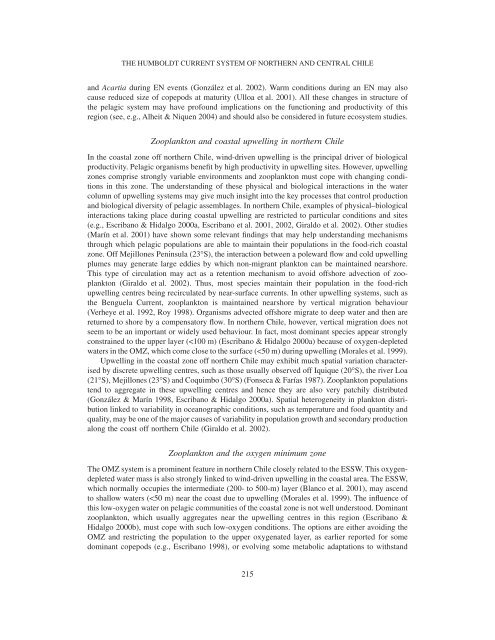MARTIN THIEL ET AL.productivity observed along <strong>the</strong> nor<strong>the</strong>rn <strong>and</strong> <strong>central</strong> coast <strong>of</strong> <strong>the</strong> HCS (23–37°S) is probablyfertilising oceanic <strong>and</strong> oligotrophic areas through <strong>the</strong> formation <strong>of</strong> eddies <strong>and</strong> filaments that transportcoastal water <strong>of</strong>fshore (Marín et al. 2003a, Hormazábal et al. 2004, Letelier et al. 2004). Finally,much <strong>of</strong> what is known about upwelling dynamics, phytoplankton ecology <strong>and</strong> <strong>the</strong>ir role inbiogeochemical cycles along <strong>the</strong> Chilean coast has been mainly ga<strong>the</strong>red from selected upwellingareas (i.e., Ant<strong>of</strong>agasta, Coquimbo, Concepción, Valparaíso) with scarce or no information fromareas in-between.Zooplankton consumersZooplankton consumers are considered <strong>the</strong> link between primary producers <strong>and</strong> higher trophiclevels in <strong>the</strong> pelagic realm <strong>of</strong> <strong>the</strong> world ocean. This function also implies a role to regulate <strong>the</strong> rateat which phytoplankton-C can be transferred through <strong>the</strong> food web or retained as zooplanktonbiomass. This rate greatly depends on population turnover rates, which vary widely among zooplanktontaxa. Thus, <strong>the</strong> knowledge <strong>of</strong> <strong>the</strong> population biology <strong>of</strong> dominant species, <strong>the</strong> communitystructure <strong>and</strong> its variation, become key issues in underst<strong>and</strong>ing <strong>the</strong> ecological <strong>and</strong> biogeochemicalrole <strong>of</strong> zooplankton. In <strong>the</strong> HCS substantial progress has been made in <strong>the</strong> last decades about some<strong>of</strong> <strong>the</strong>se issues. In <strong>the</strong> following sections we summarise <strong>the</strong> major advances in underst<strong>and</strong>ingpopulation, community <strong>and</strong> eco<strong>system</strong> processes involving zooplankton in <strong>the</strong> upwelling region<strong>of</strong>f nor<strong>the</strong>rn Chile. Much less progress is being made in molecular, genomic <strong>and</strong> genetic biology<strong>of</strong> zooplankton in this region. However, <strong>the</strong> need for a better underst<strong>and</strong>ing <strong>of</strong> zooplankton ecologyin <strong>the</strong> region will most likely motivate <strong>the</strong> use <strong>of</strong> molecular tools in <strong>the</strong> near future.Biogeographic <strong>and</strong> biodiversity issuesIn <strong>the</strong> upwelling region <strong>of</strong>f nor<strong>the</strong>rn Chile most species or species assemblages are considered tobe part <strong>of</strong> <strong>the</strong> subantarctic fauna. This fauna originates in <strong>the</strong> Austral region, but it is <strong>the</strong>n advectednorthward. In nor<strong>the</strong>rn Chile <strong>and</strong> <strong>of</strong>f Peru, it mixes with some species <strong>of</strong> tropical <strong>and</strong> equatorialorigin. The most studied taxa are Copepoda (Heinrich 1973, Vidal 1976, Hidalgo & Escribano2001) <strong>and</strong> Euphausiacea (Antezana 1978, D. Fernández et al. 2002). Nearly 60 species <strong>of</strong> copepodshave been identified, <strong>of</strong> which <strong>the</strong> dominant in <strong>the</strong> coastal zone are Calanus <strong>chile</strong>nsis, Centropagesbrachiatus, Paracalanus parvus, Acartia tonsa, Eucalanus inermis, Oithona similis, Oncaeaconifera <strong>and</strong> Corycaeus typicus. Calanus <strong>chile</strong>nsis is an endemic species <strong>of</strong> <strong>the</strong> HCS (Marín et al.1994), whereas Centropages brachiatus, Paracalanus parvus, Acartia tonsa <strong>and</strong> Oithona similisare cosmopolites <strong>and</strong> widely distributed along <strong>the</strong> Chilean coast. Eucalanus inermis is a typicaltropical species, although <strong>the</strong> genus Eucalanus may contain about six species, which have not yetbeen clearly defined. Among euphausiids, <strong>the</strong> most abundant <strong>and</strong> endemic species <strong>of</strong> <strong>the</strong> HCS isEuphausia mucronata (Antezana 1978). This species is closely associated with upwelling centres<strong>of</strong>f nor<strong>the</strong>rn Chile (Escribano et al. 2000) <strong>and</strong> performs an extensive vertical migration into <strong>the</strong>OMZ. Euphausia eximia is ano<strong>the</strong>r abundant species, which increases in number during EN(Antezana 1978, González et al. 2000b). Gelatinous zooplankton, on <strong>the</strong> o<strong>the</strong>r h<strong>and</strong>, has receivedmuch less attention, although it may form dense aggregations at times <strong>of</strong> <strong>the</strong> year in <strong>the</strong> coastalupwelling zone (Pagès et al. 2001), <strong>and</strong> it can exert a strong predation pressure on copepods(Giesecke & González 2004, H.E. González et al. 2004b, Pavez et al. 2006) <strong>and</strong> possibly on fishlarvae.Species replacements seem to occur in <strong>the</strong> zooplankton associated with EN versus LN regimes(Hidalgo & Escribano 2001). Dominant species alternate between copepods (mainly Calanus <strong>and</strong>Eucalanus genera) <strong>and</strong> euphausiids during upwelling conditions <strong>and</strong> cyclopoid copepods, Paracalanus214
THE HUMBOLDT CURRENT SYSTEM OF NORTHERN AND CENTRAL CHILE<strong>and</strong> Acartia during EN events (González et al. 2002). Warm conditions during an EN may alsocause reduced size <strong>of</strong> copepods at maturity (Ulloa et al. 2001). All <strong>the</strong>se changes in structure <strong>of</strong><strong>the</strong> pelagic <strong>system</strong> may have pr<strong>of</strong>ound implications on <strong>the</strong> functioning <strong>and</strong> productivity <strong>of</strong> thisregion (see, e.g., Alheit & Niquen 2004) <strong>and</strong> should also be considered in future eco<strong>system</strong> studies.Zooplankton <strong>and</strong> coastal upwelling in nor<strong>the</strong>rn ChileIn <strong>the</strong> coastal zone <strong>of</strong>f nor<strong>the</strong>rn Chile, wind-driven upwelling is <strong>the</strong> principal driver <strong>of</strong> biologicalproductivity. Pelagic organisms benefit by high productivity in upwelling sites. However, upwellingzones comprise strongly variable environments <strong>and</strong> zooplankton must cope with changing conditionsin this zone. The underst<strong>and</strong>ing <strong>of</strong> <strong>the</strong>se physical <strong>and</strong> biological interactions in <strong>the</strong> watercolumn <strong>of</strong> upwelling <strong>system</strong>s may give much insight into <strong>the</strong> key processes that control production<strong>and</strong> biological diversity <strong>of</strong> pelagic assemblages. In nor<strong>the</strong>rn Chile, examples <strong>of</strong> physical–biologicalinteractions taking place during coastal upwelling are restricted to particular conditions <strong>and</strong> sites(e.g., Escribano & Hidalgo 2000a, Escribano et al. 2001, 2002, Giraldo et al. 2002). O<strong>the</strong>r studies(Marín et al. 2001) have shown some relevant findings that may help underst<strong>and</strong>ing mechanismsthrough which pelagic populations are able to maintain <strong>the</strong>ir populations in <strong>the</strong> food-rich coastalzone. Off Mejillones Peninsula (23°S), <strong>the</strong> interaction between a poleward flow <strong>and</strong> cold upwellingplumes may generate large eddies by which non-migrant plankton can be maintained nearshore.This type <strong>of</strong> circulation may act as a retention mechanism to avoid <strong>of</strong>fshore advection <strong>of</strong> zooplankton(Giraldo et al. 2002). Thus, most species maintain <strong>the</strong>ir population in <strong>the</strong> food-richupwelling centres being recirculated by near-surface <strong>current</strong>s. In o<strong>the</strong>r upwelling <strong>system</strong>s, such as<strong>the</strong> Benguela Current, zooplankton is maintained nearshore by vertical migration behaviour(Verheye et al. 1992, Roy 1998). Organisms advected <strong>of</strong>fshore migrate to deep water <strong>and</strong> <strong>the</strong>n arereturned to shore by a compensatory flow. In nor<strong>the</strong>rn Chile, however, vertical migration does notseem to be an important or widely used behaviour. In fact, most dominant species appear stronglyconstrained to <strong>the</strong> upper layer (










